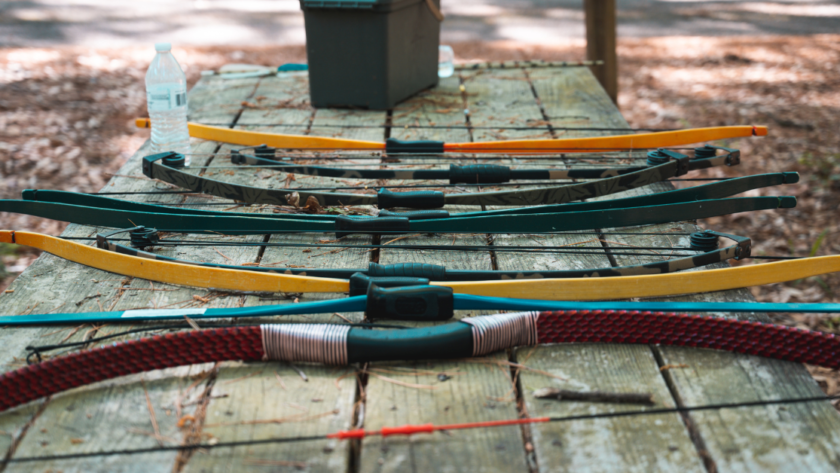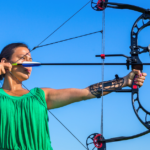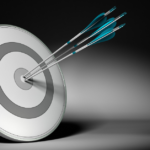As I stepped onto the archery range, the diversity of bows on display immediately caught my eye. From the graceful curves of recurves to the high-tech pulleys of compounds, each bow type told a unique story of engineering and tradition.
This stark contrast sparked my curiosity: what are the real differences between these bows, and why do they matter?
The Recurve: Elegance in Simplicity
The recurve bow, with it’s distinctive curved limbs that point away from the archer when unstrung, is perhaps the most recognizable bow type.
It’s design showcases the ingenuity of our ancestors, who uncovered that this shape could store more energy and deliver arrows with greater speed and power.
Theoretical Background
The science behind the recurve’s efficiency stems from it’s ability to distribute the force of the draw more evenly across the limbs.
When drawn, the limbs straighten out, storing energy not just in the bend of the limbs and in the “uncoiling” of their natural curve.
This results in more power being transferred to the arrow upon release.
The recurve’s design allows for a smoother draw and release compared to a straight-limbed bow. As the string is pulled back, the limbs gradually flex, creating a consistent increase in draw weight.
This smooth draw cycle helps archers maintain better control and accuracy throughout the shot.
Practical Applications
Recurve bows are the weapon of choice in Olympic archery, prized for their consistency and the pure skill required to master them.
They’re also popular among traditional archers and hunters who appreciate their portability and connection to historical archery techniques.
In competitive target archery, recurve bows are often fitted with stabilizers, sights, and other accessories to enhance accuracy and performance.
However, many archers choose to shoot recurves “bare bow” style, relying solely on their skill and instincts to aim and shoot accurately.
For hunting, recurve bows offer a lightweight and maneuverable option, making them ideal for stalking game in dense forests or shooting from tree stands.
Their simple design means fewer parts that can fail in the field, and their quiet operation helps prevent spooking animals.
Overcoming Challenges
One of the main challenges with recurve bows is the need for consistent form. Without the mechanical advantages of compound bows, archers must develop and maintain precise muscle memory to achieve accuracy.
This can be overcome through regular practice and proper coaching.
To master the recurve bow:
- Focus on developing a consistent anchor point – the spot where your drawing hand touches your face at full draw.
- Practice proper back tension, using the large muscles of your back to hold the draw rather than relying solely on arm strength.
- Work on a smooth release technique, allowing the string to slip off your fingers without disturbing the bow’s alignment.
- Experiment with different arrow spine ratings to find the perfect match for your bow’s draw weight and your shooting style.
- Consider using a bow stringer to safely string and unstring your recurve, protecting the limbs from potential damage.
The Compound: Power Meets Precision
Invented in the 1960s, the compound bow revolutionized archery with it’s system of pulleys and cables. At first glance, it might look intimidatingly complex, but this design offers significant advantages to the modern archer.
Key Concepts
The compound bow’s defining feature is it’s let-off, which reduces the holding weight at full draw. This means an archer can hold the bow at full draw for longer, allowing for more precise aiming.
The use of cams (the wheel-like mechanisms at the ends of the limbs) also creates a “wall” at full draw, providing a consistent anchor point.
Let’s break down the key components of a compound bow:
- Cams: These eccentric wheels at the end of the limbs control the bow’s draw force curve.
Different cam designs (single cam, dual cam, hybrid cam, binary cam) offer varying performance characteristics.
- Cables: Working in conjunction with the cams, cables help transfer energy from the limbs to the string.
- Limbs: Usually made of composite materials, compound bow limbs are shorter and stiffer than those on recurve bows.
- Riser: The central part of the bow that houses the grip and provides mounting points for accessories like sights and stabilizers.
- String: Typically made of high-performance materials like Dyneema, the string transfers energy from the limbs to the arrow.
Implementing the Technique
To shoot a compound bow effectively:
- Start with proper bow fitting, ensuring the draw length matches your arm span.
A bow that’s too long or short will severely impact your accuracy and comfort.
- Learn to use the release aid, a mechanical device that clips onto the bowstring for a cleaner release.
There are various types of releases, including wrist-strap, handheld, and thumb-activated models.
- Practice maintaining a steady hold at full draw, taking advantage of the reduced holding weight.
This is where the compound bow’s let-off really shines, allowing you to focus on aiming without fighting against the full draw weight.
- Use the bow’s sights and stabilizers to enhance accuracy.
Many compound bows come equipped with multi-pin sights, allowing you to compensate for arrow drop at different distances.
- Develop a consistent anchor point and release technique.
Even with the mechanical advantages of a compound bow, good form is still crucial for accuracy.
- Experiment with different arrow weights and broadhead designs to find the optimal setup for your shooting style and intended use (target shooting vs. hunting).
Common Pitfalls
One common mistake is over-relying on the bow’s technology and neglecting basic form. Remember, even with all it’s advantages, a compound bow still needs skill and practice to master.
Here are some pitfalls to avoid:
- Improper draw length: A bow that’s not correctly fitted can lead to poor accuracy and potential injury.
- Punching the trigger: Jerking the release aid instead of using a smooth, controlled release can cause inconsistent shots.
- Neglecting bow maintenance: Compound bows need regular tuning and maintenance to perform at their best.
- Overbow: Choosing a draw weight that’s too heavy can lead to poor form and accuracy.
- Ignoring the follow-through: Just like with other bow types, maintaining your form through the shot is crucial for accuracy.
The Longbow: A Test of Skill and Tradition
The longbow, with it’s simple D-shaped profile, represents archery in it’s purest form. Made traditionally from a single piece of wood, these bows need a deep understanding of material properties and shooting technique.
Historical Significance
Longbows have played a crucial role in history, most famously in the hands of English and Welsh archers during the Hundred Years’ War.
The longbow’s ability to deliver arrows with devastating power and range changed the face of medieval warfare.
Traditional longbows are typically made from a single piece of wood, often yew, ash, or hickory. The bow’s length – usually equal to or greater than the archer’s height – allows for a smooth draw and effective energy transfer to the arrow.
Shooting Technique
Shooting a longbow effectively requires mastering several key elements:
- Stance: A proper stance provides a stable platform for the shot.
Most longbow archers use a slightly open stance, with the feet shoulder-width apart.
- Grip: The bow hand should hold the bow loosely, allowing it to pivot slightly upon release.
- Draw: Unlike with recurve or compound bows, longbow archers typically draw to the corner of the mouth or the chin, rather than under the jaw.
- Aiming: Many longbow archers use instinctive aiming, where they focus on the target rather than using sights or reference points on the bow.
- Release: A clean release is crucial for accuracy.
The fingers should relax smoothly, allowing the string to slip off without disturbing the bow’s alignment.
Adapting to Different Scenarios
While longbows might seem outdated compared to their modern counterparts, they offer unique advantages in certain situations. In dense forests, where maneuverability is key, the longbow’s simplicity shines.
It’s quiet draw and release make it ideal for hunters who need to stay undetected.
For traditional bowhunters, the longbow offers a challenging and rewarding experience. The lack of sights or other aiming aids means success relies entirely on the archer’s skill and instincts.
This can lead to a deeper connection with the hunting experience and a greater sense of accomplishment when successful.
Building on Basics
Achieving proficiency with the longbow teaches archers basic skills that translate to all forms of archery. The focus on instinctive aiming and understanding arrow flight dynamics builds a strong foundation for any archery discipline.
Some key skills developed through longbow archery include:
- Body awareness: Without sights or other aids, longbow archers must develop a keen sense of their body position and movement.
- Mental focus: The simplicity of the longbow allows archers to concentrate fully on the shot process without distractions.
- Understanding arrow flight: Longbow archers become intimately familiar with how factors like draw weight, arrow spine, and fletching affect arrow flight.
- Patience and persistence: Becoming Better at the longbow takes time and dedication, fostering valuable mental attributes.
The Crossbow: Bridging Traditions
Crossbows occupy a unique space in the archery world, blending elements of archery and firearms. Their rifle-like design and trigger mechanism make them accessible to a wide range of users, including those with physical limitations that might prevent them from using traditional bows.
Historical Context
Crossbows have a long and varied history, dating back to ancient China and playing significant roles in European medieval warfare. Today, they’re used primarily for hunting and target shooting, offering a unique blend of archery and firearm-like characteristics.
Key Components
Understanding the parts of a crossbow is crucial for effective use:
- Stock: Similar to a rifle stock, this provides a stable platform for shooting.
- Prod: The bow part of the crossbow, often made of composite materials in modern designs.
- String: Typically made of high-strength materials like Dyneema.
- Trigger mechanism: Allows for precise release of the string.
- Scope or sights: Most modern crossbows use scopes for accurate aiming.
- Stirrup: A foot hold used to brace the crossbow while cocking.
Shooting Technique
Shooting a crossbow effectively involves several key steps:
- Cocking: This can be done manually or with a cocking device.
Consistent cocking is crucial for accuracy.
- Loading: Place the bolt (crossbow arrow) in the flight groove, ensuring it’s seated properly.
- Aiming: Use the scope or sights to align with your target, accounting for distance and wind.
- Firing: Squeeze the trigger smoothly, maintaining your aim through the shot.
- Follow-through: Keep the crossbow steady until the bolt hits the target.
Practical Exercises
To improve your crossbow skills:
- Practice proper cocking techniques to confirm consistent draw weight.
This might involve using a cocking rope or crank mechanism for more powerful crossbows.
- Experiment with different bolt weights to find the optimal balance between speed and accuracy.
Heavier bolts often provide better penetration for hunting, while lighter bolts might offer flatter trajectories for target shooting.
- Learn to compensate for the crossbow’s unique trajectory at different distances.
Unlike firearms, crossbow bolts have a more pronounced arc, requiring significant adjustment for longer shots.
- Practice shooting from various positions – standing, kneeling, and prone – to prepare for different hunting or competitive scenarios.
- Familiarize yourself with your crossbow’s safety features and always prioritize safe handling practices.
Key Takeaways
- Recurve bows offer a balance of tradition and performance, ideal for those seeking a pure archery experience.
They need consistent form and practice to master but provide a deeply rewarding shooting experience.
- Compound bows provide mechanical advantage and precision, making them popular for hunting and competitive target archery.
Their let-off and adjustability make them accessible to a wide range of archers, but they need proper setup and maintenance.
- Longbows challenge archers to master basic skills, offering a connection to archery’s historical roots.
They excel in simplicity and quiet operation, making them ideal for traditional hunters and those seeking to hone their instinctive shooting skills.
- Crossbows provide accessibility and ease of use, bridging the gap between archery and firearms.
They offer advantages in terms of power and accuracy but come with their own unique shooting techniques and legal considerations.
- Each bow type has it’s strengths and challenges, catering to different preferences and shooting styles.
The best choice depends on your personal goals, physical abilities, and intended use.
Frequently Asked Questions
What’s the difference between a recurve and a longbow?
Recurve bows have limbs that curve away from the archer when unstrung, while longbows have a simple D-shaped profile. Recurves typically offer more power and speed for a given draw weight, while longbows are prized for their simplicity and traditional appeal.
Are compound bows more accurate than recurves?
Compound bows can be more forgiving and easier to shoot accurately, especially for beginners, because of their let-off and mechanical advantages. However, top-level archers can achieve remarkable accuracy with both types of bows.
What type of bow is best for beginners?
Many beginners start with recurve bows because of their simplicity and lower cost. However, compound bows can also be good for beginners, especially those interested in hunting, as they’re easier to hold at full draw.
How much draw weight do I need for hunting?
The required draw weight varies depending on the game you’re hunting and local regulations. Generally, 40-50 pounds is considered least for deer hunting with compound bows, while recurves and longbows might need 45-55 pounds or more.
Can I use a crossbow for bowhunting?
Crossbow regulations vary by location. In some areas, they’re fully legal for bowhunting, while in others, they may be restricted to certain seasons or hunters with disabilities.
Always check local regulations before hunting with a crossbow.
What’s the effective range of different bow types?
Effective range varies greatly depending on the archer’s skill, the bow’s power, and the intended target. As a rough guide:
- Longbows: 20-40 yards
- Recurves: 30-50 yards
- Compound bows: 40-60 yards
- Crossbows: 50-80 yards
How often should I replace my bowstring?
For compound bows, strings and cables typically need replacement every 2-3 years or 2,500-3,000 shots. Recurve and longbow strings may last longer but should be inspected regularly and replaced if showing signs of wear.
What’s the difference between target archery and bowhunting?
Target archery focuses on accuracy at known distances, often using specialized equipment. Bowhunting requires extra skills like stealth and shot placement on animal targets, often at unknown distances and in varied terrain.
How do Olympic archery rules differ from other competitions?
Olympic archery uses recurve bows exclusively and has specific rules about equipment and scoring. Other competitions may allow different bow types and have varying rules for distances, scoring, and equipment.
What’s the history of compound bows?
Compound bows were invented in 1966 by Holless Wilbur Allen. They revolutionized archery by introducing a mechanical system that made bows more effective and easier to use, quickly gaining popularity in both hunting and target archery.



